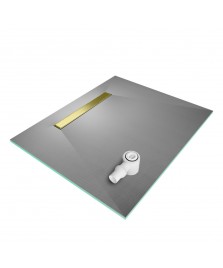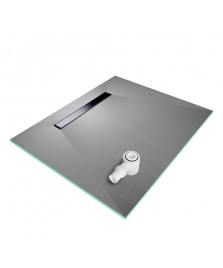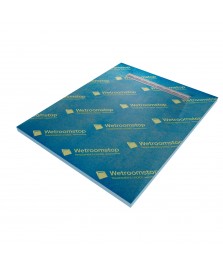- today
- perm_identity Chris Miller
- label Wet Room Kits
- favorite 0 likes
- remove_red_eye 1350 views

For wheelchair users, the bathroom can present numerous challenges that compromise comfort, accessibility, and safety. However, with thoughtful design tailored to accessibility needs, wet rooms can transform the bathroom into a welcoming and functional space.
We explore the significance of wheelchair accessible wet rooms, their benefits, and the considerations involved in their successful design.
The Need for Wheelchair Accessible Bathrooms
Standard bathrooms rarely accommodate the needs of wheelchair users. Narrow doorways obstruct access, while confined floor spaces limit manoeuvrability. Moreover, raised shower curbs and a lack of grab bars heighten the risk of dangerous slips or falls during transfers.
The Suitability of Wet Rooms for Wheelchair Accessibility
Wet rooms provide a much safer and more practical solution than traditional bathrooms. Unlike standard bathrooms, wet rooms contain the shower area within the whole room rather than being a separate enclosure. This means the entire floor is sloped towards drainage and waterproofed.
Their open-plan layout removes restrictive barriers, allowing convenient access for wheelchairs. The flush entry eliminates trip hazards, while non-slip floors grant stability. Wet rooms enable safe showering when thoughtfully equipped with appropriate grab bars, seats, and easy-to-reach controls.
Key Design Considerations
Successfully designing a wet room with wheelchair access requires careful planning and attention to vital details. Below are the main design elements to consider.
Doorways
The room's entry point impacts overall accessibility. In addition to the above opening width, consider pocket or sliding doors to optimise limited space. Automatic opening options are also ideal.
Zero-Threshold Entry
One of the primary features of a wheelchair wet room is a zero-threshold entry. This design eliminates any step or ledge at the entrance, making it easy for a wheelchair to glide in and out effortlessly.
Flooring
Non-slip, level flooring is essential for preventing slips and easing mobility. Materials like vinyl and resin are suitable options, providing grip even when wet. In addition, sheet vinyl with heat-welded seams prevents surface build-up while resisting bacteria.
Appropriate Drainage
A gently sloping floor towards the drain and a suitable drainage system ensure that the wet room remains safe and functional. Linear drains stretch across the entire floor area, preventing puddles. Position the drain near the wet room entrance to keep the main area of the wet room clean and dry.
Waterproofing
Thorough waterproofing safeguards the rest of the home from water damage. The entire wet room, including the floors, walls, and all joints and pipe penetrations, must be waterproofed with membranes and sealants to create a fully tanked, watertight environment.
Accessible Fixtures and Fittings
From taps and showerheads to toilets and vanities, all fixtures in the wet room for the wheelchair user must be easily reachable and operable. Large, lever-type handles are easy to adjust, wall-hung sanitaryware saves floor space, and detachable shower heads allow customised spray positioning.
Support Features
Strategically placed grab bars allow users to safely transfer and stabilise themselves. Opt for corrosion-resistant metal bars with a non-slip coating. Position bars near the shower area, toilet, and doorway.
An ergonomic wheelchair accessible shower seat is another essential feature for comfortable bathing. Choose a wall-mounted design that allows easy access.
Adequate Lighting
It's crucial to have bright, even lighting throughout the room to avoid shadows and dark spots, which can pose a risk for accidents. Adjustable or dimmable lights can be beneficial for different times of the day or for users with light sensitivity.
Innovative Wet Room Ideas for Wheelchair Users
The beauty of wet rooms with wheelchair access lies in their versatility. Incorporating elements like underfloor heating, wall-mounted toilets, and fold-down seats can enhance the functionality and comfort of a wheelchair wet room.
Wet rooms can also be customised to suit individual preferences in design and style. For example, using glass panels instead of curtains can make the space feel larger and more open. Decorative tiles and mirrored surfaces can add personality to the wet room. Contrasting colours and materials can inject vibrancy into the space, as well as aid visibility.
In addition, consider incorporating as much natural light into the wet room as possible. Windows or skylights not only make the room feel more spacious and invigorating, but they also aid in ventilation, contributing to a safer and cleaner bathing experience.
Remember, the key to a successful wheelchair accessible wet room is balancing functionality, safety, and personal style.
Design Exceptional Wet Rooms for Wheelchair Users with Wetroomstop
Wet room solutions can transform restrictive bathrooms into accessible sanctuaries for those with mobility restrictions. Creating a wet room for a wheelchair user is a thoughtful process that requires attention to detail and a deep understanding of the individual's needs.
Specialist suppliers like Wetroomstop can simplify this process. We offer a range of products specifically designed for wheelchair-friendly wet rooms. From wet room shower trays and drainage solutions to waterproofing materials, we have everything you need to create a fully accessible wet room.
Our years of experience in wet rooms ensure that every aspect of a wheelchair accessible wet room is addressed, offering both functionality and elegance. Contact us today for more information or advice from our friendly team.

















